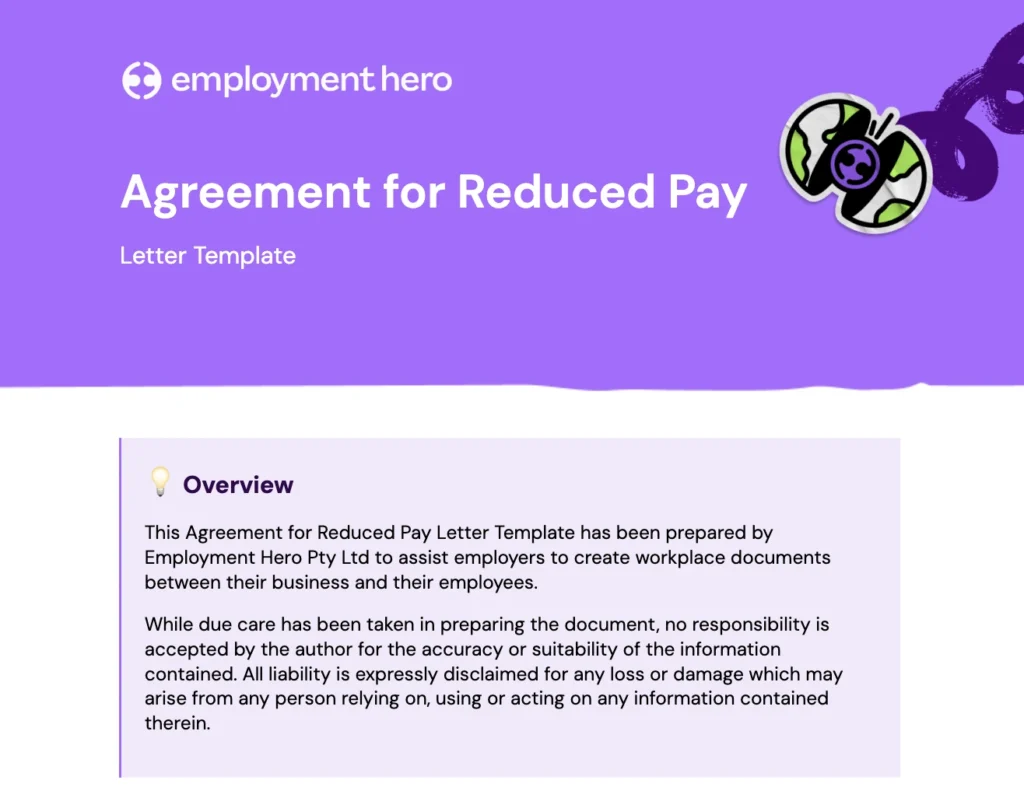Salary reduction letter and agreement template: A practical guide for Australian businesses
Published
Salary reduction letter and agreement template: A practical guide for Australian businesses
Navigating economic uncertainty isn’t easy, especially when tough decisions like salary reductions come into play.
When times are tough, we know how important it is to have clear, practical guidance you can trust. That’s why we’ve created this guide and customisable template.
In here, you’ll find all the information you need to confidently manage salary reductions, with fairness at every step.
Inside the salary reduction letter template
We’ve designed the template specifically for Australian businesses, incorporating all the essential elements for a legally sound salary reduction. In here, you’ll find:
- The “why”: The reason for the reduction, whether it’s due to economic downturn, company restructuring or other factors.
- Current and proposed salary: The employee’s current salary and the proposed reduced salary.
- Effective date: The date the salary reduction will take effect, allowing for a smooth transition.
- Employee agreement: A section for the employee to acknowledge and agree to the salary reduction.
This template is designed to promote transparency and make it easier to manage reduced pay arrangements. By using a standardised template, you can make sure every conversation is handled consistently, professionally and in line with best practices.

When is a salary reduction appropriate?
Salary reductions are often considered during times of economic hardship or when a business needs to restructure to remain viable. They can be a strategic alternative to layoffs, helping to retain valuable employees while managing costs.
Some common scenarios where salary reductions might be considered include:
- Economic downturn: A significant downturn in the economy can impact company revenue, necessitating cost-saving measures.
- Company restructuring: Internal restructuring or mergers may require adjustments to salary structures.
- Financial difficulties: Unexpected financial challenges may require temporary salary reductions to stabilise the business.
Reducing salaries is never an easy call, and one that can weigh heavily on your team. Before making any changes, it’s important to carefully balance your business’s financial needs with the wellbeing, trust and motivation of your people.
Are salary reductions always temporary?
While often used as a temporary measure, salary reduction agreements can also be used for permanent salary adjustments. Your letter must explicitly state whether the reduction is temporary or permanent, however please note that this template is for a temporary salary reduction.
Negotiating the salary reduction
Open and honest communication is essential when discussing salary reductions with employees.
- Transparency: Clearly explain the reasons for the reduction and how it will impact the employee’s salary.
- Collaboration: Work with your human resources manager to present the current and proposed salary to the employee, allowing for questions and discussion.
- Fairness: Ensure the proposed salary is fair and reasonable, taking into account the employee’s experience, skills and contributions to the company.
Minimum wage considerations
Australian businesses must adhere to the National Employment Standards (NES), which include minimum wage requirements. It’s crucial to ensure that any salary reduction does not result in an employee’s salary falling below the legal minimum wage.
Informing employees about the salary reduction
The process should be transparent, respectful and you should consider the following:
- Formal letter: Use a formal salary reduction letter (like our template) to clearly communicate the details of the reduction, including the reason, the new adjusted salary and the date it will be effective from.
- Delivery: The letter should be delivered by the human resources manager or a manager, providing an opportunity for the employee to ask questions and discuss any concerns.
- Signed agreement: Include a section in the letter for the employee to sign, acknowledging their understanding and agreement to the salary reduction.
Understanding the risks of salary reductions
While salary reductions can be a necessary step for businesses, it’s important to be aware of the potential risks.
Impact on morale and productivity
Salary reductions can impact employee morale and motivation, potentially leading to decreased productivity and increased turnover.
Legal risks
Non-compliance with Australian employment laws, such as the Fair Work Act 2009, can result in legal challenges and penalties.
Reputational damage
Mishandled salary reductions can harm a company’s reputation, making it difficult to attract and retain talent.
Unintended consequences
If not implemented strategically, salary reductions may not achieve the desired cost savings and could potentially lead to the need for layoffs in the future.
Key considerations for a smooth process
- Clear communication: Maintain open and honest communication with employees throughout the process.
- Managing compliance: Ensure full compliance with Australian employment laws.
- Fairness and transparency: Implement the salary reduction fairly and transparently, minimising the impact on employees.
- Providing support: Provide support to employees during this time, addressing their concerns and answering their questions.
By approaching salary reductions with careful planning, clear communication and a focus on fairness, businesses can navigate these challenges effectively and maintain a positive working environment.
Download the letter template now by filling on the form on the right.
The information in this guide is current as at 8 October 2025, and has been prepared by Employment Hero Pty Ltd (ABN 11 160 047 709) and its related bodies corporate (Employment Hero). The content is general information only, is provided in good faith to assist employers and their employees, and should not be relied on as professional advice. Some information is based on data supplied by third parties. While such data is believed to be accurate, it has not been independently verified and no warranties are given that it is complete, accurate, up to date or fit for the purpose for which it is required. Employment Hero does not accept responsibility for any inaccuracy in such data and is not liable for any loss or damages arising directly or indirectly as a result of reliance on, use of or inability to use any information provided in this guide. You should undertake your own research and seek professional advice before making any decisions or relying on the information in this guide.























